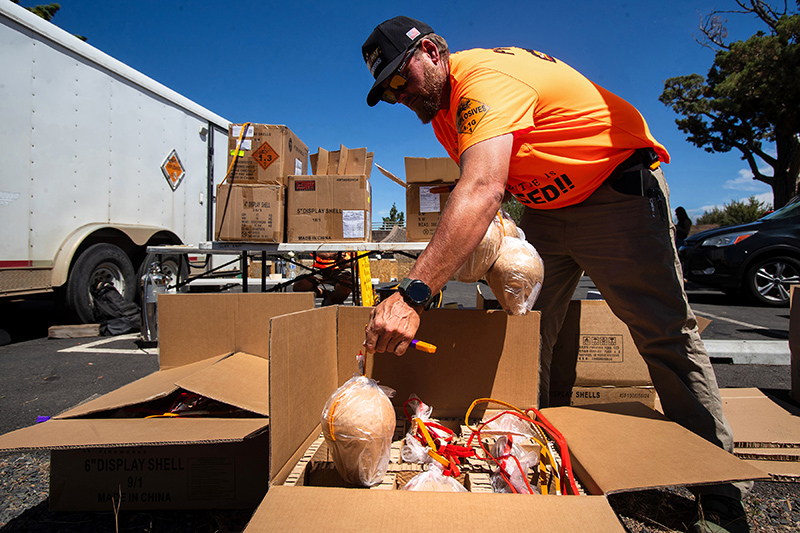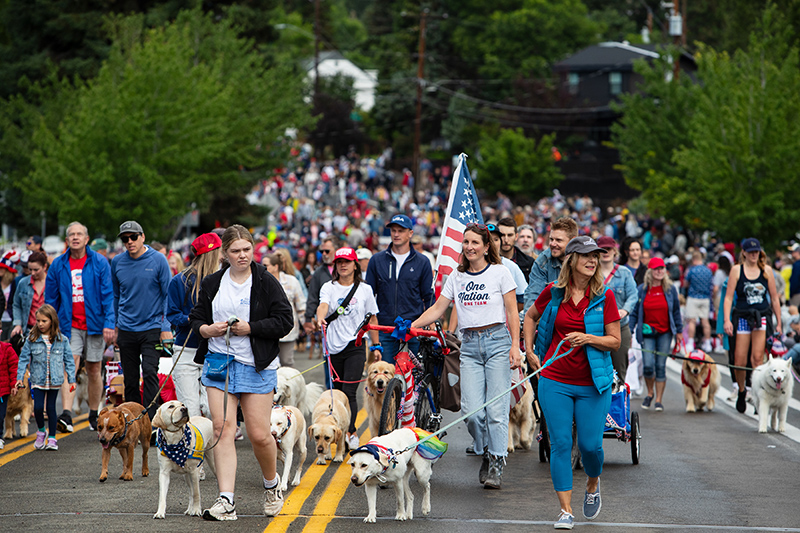With aging attrition, quilters on mission for more members
Published 12:00 am Saturday, July 14, 2018

- A "double wedding ring" quilt, made by a member of the Bend Quilters, is viewed during the group's weekly meeting on Tuesday, July 10, 2018, at the Newport Avenue Church of Christ in Bend. (Joe Kline/Bulletin photo)
When quilter Nada Torgerson moved to Bend from Anchor Point, Alaska, in 2014, she was eager to find her people. At her first visit to the Bend Quilters, a local club devoted to her favorite pastime, Torgerson felt right at home.
“I walked in the door, and I said, ‘This is my new family,’” recalled Torgerson, whose first name is pronounced NAY-duh.
Torgerson, 80, has since enjoyed countless quilting sessions with the eight other quilters who round out the club. The Bend Quilters is celebrating its 40th anniversary on July 18.
While the group doesn’t have anything special planned, it is looking for few good quilters to join its ranks. No previous quilting experience is necessary.
“We’re a social club that uses quilting as an excuse,” Arline McDonald, 83, said with a chuckle.
Judi Deeks, 69, chimed in.
“But if you were expecting stodgy old ladies, you’d be wrong,” Deeks said. “And we’ve already mentioned politics.”
The Bend Quilters is one of several quilting groups in Central Oregon. These quilters are “purists” who abide by traditional hand-quilting techniques. This method yields richer results, they say, than mechanized “long-arm quilting” techniques, which require something similar to a sewing machine.
However, handmade quilts take months to finish instead of weeks.
“This is old-fashioned quilting,” said Caroline Tabor, 73. “Hand quilting has been done for thousands of years.”
‘Whole cloth’
The quilters meet each Tuesday at the Newport Avenue Church of Christ in Bend from 10 a.m. to 2 p.m. In a back room, they stretch fabric across a wooden frame about the size of a dinner table. Members sit around the quilt like numbers on a clock face. Each is equipped with quilting needles, pliers, scissors and spools of 100 percent cotton thread. They wear thimbles to push the threaded needles in and out of the fabric three times before pulling them through with pliers. Then they begin the process again.
On this day, the nine members surrounded a queen-size, all-white quilt whose top sheet featured a floral pattern outlined by thin blue chalk that will later wash out. Torgerson bought the premarked fabric at a New Hampshire quilt store famous among quilters.
Traditional quilts take anywhere from 9 to 12 months to complete, the group said. Before they’re done, the quilters will have introduced more than 1,000 yards of thread into the quilt — a typical amount, Tabor said. This quilt is “whole cloth,” which means the quilters didn’t cut it into pieces the way they do to make a scrap quilt or a piece quilt. The whole-cloth quilt’s beauty will lie in the rippled texture that the floral design will lend to the top fabric, which is thickened by an insulating middle layer called batting and a durable backing sheet.
At a nearby table, a dozen folded quilts, all made by the Bend Quilters, displayed the craft’s myriad possibilities.
“This is only the tip of the iceberg,” said Tabor, describing each quilt one-by-one. “If all our quilts were here they’d be stacked in the corners!”
The quilts featured different fabrics they have sewn together, embroidered or appliqued. Geometric colors pinwheel and whorl. In one quilt, which primary quilter Katsuko “Boots” Buldoc, 85, made in the double wedding ring design, small printed pieces of fabric — think polka dots, paisleys and cats at play — loop like carousels. Other quilts feature the friendship design, where quilters contribute dinner plate-size blocks to be sewn together to make a top. Each block, or a small quilt top portion, is signed by each participating quilter. Some quilts featured the Kansas sunflower, which adds three dimensionality with pleated fabric petals. They’re the signature design of Shirley Robinson; each member has their own.
“You can see we don’t rush into things,” said Patsy Vincent, 89, who has been with the Bend Quilters since 1992.
Sewn together
Each quilter arrived at quilting in her own way. Tabor began quilting in 1989. She had tried out embroidery, knitting, making clothes, rug hooking and crocheting, but nothing “fit,” she said, until she stumbled onto a quilting show on TV hosted by master quilter Eleanor Burns.
“I was watching TV one day in November, and I needed to make Christmas gifts for my two teenage nieces,” Tabor said. “(Burns) said you can make a quilt in a day.”
Tabor was intrigued and jotted notes during the program. When it was over, she left to buy fabric.
“It didn’t take me a day to make a quilt — it took me a week,” Tabor said with a laugh. “But I made a quilt for each of my nieces, and I finished before Christmas.”
Tabor has been a member of Bend Quilters since 1994.
“I had tried every hobby known to man and woman; there was just something about quilting that just hooked me,” Tabor said. “Quilting just fit. I fell in love, and I’ve been doing it every day ever since. All the other hobbies fell to the side.”
Bend Quilters now has nine members. It had around 18 in recent years. The four founding members — Mary Kroker, Pearl Raco, Betty Christiansen, and Bonnie Ward — have died.
“It was Mary who said, ‘We all quilt. Why don’t we quilt together?’” Tabor said, adding that the founders wrote rules and made decisions about how the group would go. They also worked on commissioned, custom quilts. That practice ended around the early 1990s. Currently, quilters take turns having their quilts worked on by the group.
Throughout the decades, the group has experienced a “slow attrition” as members grew too old to drive or moved away to be closer to adult children, Tabor said.
“We have room for more,” Tabor said, adding that they have a second quilt frame that goes unused.
The group lost another member when Bonnie Beth Clausen, 91, died on July 5. When she had a stroke years ago that affected the right side of her body, she had to become a left-handed quilter. The group situated her at the corner so she could better quilt with her left hand. Clausen wasn’t known just for her needle work.
“Bonnie said what she thought,” Deeks said. “When she could get a word in edgewise with us.”
The group remembers friends by looking at the quilts they made together.
“These quilts are memory quilts, and they’re heirlooms,” Tabor said. It’s “fun to look at them and say, ‘I think this is where Bonnie quilted.’” “Hopefully, in a 100 years from now, someone will look at the quilts and know who did it.”
Selectively priceless
When the Bend Quilters finish a quilt, the owner will bind it, or put some trim around the edges, Tabor said. Sometimes that’s a group effort. Then the primary quilter will sign and date the piece. The group is mostly dedicated to bed quilts, but it will make the occasional lap quilt.
“We just don’t give a quilt to someone who will use it as a dog blanket or something like that,” Tabor said with a chuckle.
But the group’s less protective of its “UFOs,” or unfinished objects. Deeks never finished the first quilt she started in 1995, but said she salvaged some fabric from it.
“You should have sold it,” Torgerson said, describing the “Trip Around The World” quilt she made that she wasn’t happy with. “I sold that for $200.”
Deeks nodded and said she once did the same, putting the $350 proceeds toward a trip to the International Quilt Show in Houston.
While the Bend Quilters are all women, they aren’t opposed to male members. To the contrary, some men quilters have shown an intuition for beautiful geometrics, Tabor said.
“But if he started telling us what to do,” Tabor added with a glint in her eye. “I’d tell him, ‘You know, there are other quilting groups in Bend.’”
— Reporter: 541-617-7816, pmadsen@bendbulletin.com








